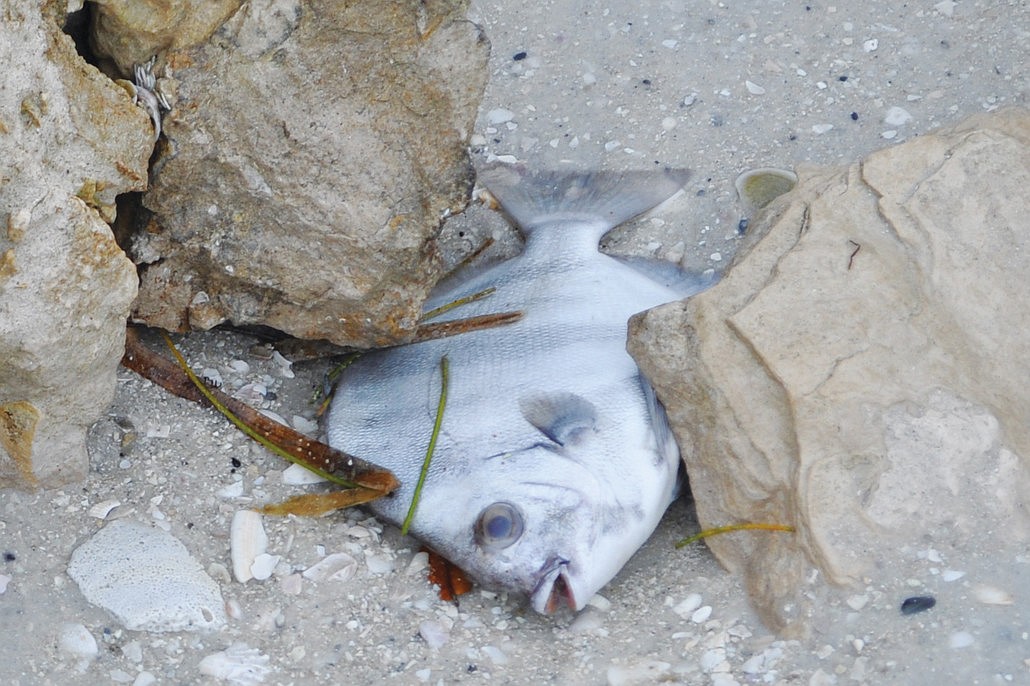- November 27, 2024
-
-
Loading

Loading

A sea of silver shimmered on the shores of Siesta Key beaches Jan. 17, after thousands of mullet washed ashore north Sarasota County beaches.
The level of Karenia brevis, the bacteria that causes red tide, was more than 1 million per liter of seawater tested by the Florida Health Department Jan. 16, off the coast of Siesta. The Florida Fish and Wildlife Commission considers that a high concentration level that kills fish and causes respiratory problems in humans.
Mullet, which have a vegetarian diet, are eating the toxic algal bloom, which explains their significant presence among the dead fish, said Mote Marine Laboratory Senior Scientist Barbara Kirkpatrick.
The current bloom has lingered near the Collier County coast for at least four months. It drifted into South Sarasota County in October but was pushed offshore shortly after by northerly and northeasterly winds.
Now, currents and wind patterns have elongated the red-tide bloom to stretch 140 miles along the Gulf Coast from Pinellas County to Collier County.
“We’re kind of at the mercy of the weather,” Kirkpatrick said.
Weather forecasts for Jan. 24 through Jan. 26, show wind patterns similar to those that pushed the bloom offshore in October. But, the possibility is slim that a major storm will sweep the bloom far enough offshore that it will cease to trouble county beaches, Kirkpatrick said.
“Unfortunately, this is a pretty significant event in terms of the amount of fish killed,” said Sarasota County Parks and Recreation Manager George Tatge.
John Hartrampf, who owns a rental property on Blind Pass Road, said he hired someone to clean the beach in front of his residence, which doesn’t fall under county beach-cleaning responsibilities.
The county is only responsible for cleaning portions of Siesta beaches with public access, said Sarasota County Commissioner Nora Patterson during a Jan. 17 Tourist Development Council meeting.
Hartrampf will refund rent money to a Rhode Island family who is in the middle of a two-week stay at his property.
“I sure pay a lot of money in bed taxes and it’s supposed to go to taking care of the beach,” Hartrampf said in a Jan. 22 phone interview. “This has become a health hazard.”
Sarasota County lifeguards reported cases of sinus issues, watery eyes and throat irritation ahead of the fish kills, said Tom Higginbotham, environmental health administrator with the Sarasota County Health Department.
As of Jan. 22, county staff and Sarasota County Sheriff’s Office Work Program inmates collected more than 40 tons of dead fish from Lido Key and Siesta Key beaches combined. Tatge said there would be a significant increase in that number after crews clean Turtle Beach, which began the same day.
“There are some pretty big fish washing up there,” Tatge said.
Snook, grouper, sea trout and puffer fish were among the fish that washed ashore on Siesta.
“The toxin that produces red tide is not going to be discriminatory,” Kirkpatrick said.
The Tourist Development Council Jan. 22 — the same day of the initial fish kills — voted to urge Sarasota County commissioners to extend funding for beach cleaning out of the tourist development tax revenues for two years.
The county allocated roughly $3,000 in beach maintenance in the 2013 fiscal year.
County and inmate crews have returned to the same north county beaches to clear dead fish at least one subsequent time, indicating there have been sustained kills sending the fish to area shores.
The county may also contract day laborers to help with the cleanup effort, Tatge said.
The Florida Department of Environmental Protection restricts cleaning on every beach area on Siesta, except the main public beach, to hand cleaning, which is more laborious. But, two beach-cleaning vehicles were on-site at Siesta public beach the weekend after the Jan. 17 fish kill.
“This is a really good-size bloom these fish got into,” Tatge said.